Put your growth on autopilot
GrowSurf is modern referral program software that helps product and marketing teams launch an in-product customer referral program in days, not weeks. Start your free trial today.
Let me guess:
After reading the word "guerrilla," your mind wandered off to images of military tactics and unconventional warfare. While the term does have its roots in guerrilla warfare tactics used by revolutionary groups, in the context of marketing it takes on a different meaning.
Although there are similarities between guerrilla warfare and guerrilla marketing in terms of taking an unconventional, creative approach, the marketing form does not actually involve any violence or aggression. As the U.S. Small Business Administration defines it, "Guerrilla marketing is an advertising strategy that maximizes returns while minimizing investment. It relies heavily on time, energy, imagination and an insatiable appetite for marketing opportunities."
And it can be a fantastic way for businesses of any size - but especially smaller brands and startups - to promote themselves in a cost-effective yet creative and attention-grabbing way. As marketing expert Jay Conrad Levinson, who coined the term "guerrilla marketing" in his 1984 book Guerrilla Marketing, wrote: "The soul and essence of guerrilla marketing have become efforts that are inexpensive and represent an investment of energy instead of money."
Here's an overview of what guerrilla marketing is, its key benefits and challenges, and 10 real-world examples from innovative brands to inspire your own creative guerrilla campaigns. We'll cover:
Guerrilla marketing is a form of unconventional, innovative advertising that focuses on creating buzz, word-of-mouth, and memorable personal interactions and experiences. It relies heavily on creativity, imagination, and unconventional tactics rather than large marketing budgets. As the American Marketing Association states, "Guerrilla marketing is an advertising strategy that focuses on low-cost, unconventional marketing tactics that yield maximum results."
It's an ideal approach for startups, small businesses, and companies with limited marketing resources that want to make a big impact and get people talking about their brand in creative ways.
While guerrilla marketing is especially well-suited for small businesses and startups, large companies have also embraced these unconventional tactics to cut through the noise, generate buzz on social media, and stand out from competitors. As marketing expert Jill Avery notes in her book Relevance: The Power to Change Minds and Behavior and Stay Ahead of the Competition, "Guerrilla marketing is becoming an increasingly essential component of some of the biggest product launches and re-brandings in the world."
Like guerrilla soldiers who use unusual tactics like ambushes and sabotage to fight a larger traditional military force, guerrilla marketers find creative, unconventional ways to promote their products or services without relying on traditional advertising channels like agencies, TV, radio, etc. As marketing expert Paul Suggett writes in his book Guerilla Marketing Weapons, "Guerrilla marketing renders the conventional marketing practices of big businesses ineffective and turns their size into a weakness rather than a strength."
But you're probably thinking:
Who first coined the term "guerrilla marketing" and pioneered these innovative promotional tactics?
The concept was introduced by business writer Jay Conrad Levinson in his 1984 book Guerrilla Marketing. Levinson drew inspiration from guerrilla warfare tactics used by rebels to market products and services in an unconventional, low-cost way. As he wrote in the book's introduction, "The notion of guerrilla marketing is simply the concept of achieving conventional goals using unconventional means."
While marketing practices have evolved significantly since the 1980s, guerrilla marketing remains highly relevant today. As Levinson stated, "The principles of guerrilla marketing will never change, but the tactics and tools will. The soul of guerrilla marketing will always be to spend little money to make big profits." Companies across industries continue to embrace these innovative, cost-effective tactics to create buzz, drive brand awareness, and make a memorable impression on potential customers in creative ways.
Guerrilla marketing offers several key advantages, especially for smaller brands and startups:
Just like there are different types of paid advertising, the same thing is true for guerrilla marketing. There are several ways how you can surprise your intended audience, including:
Ambush marketing is exactly what you think it is:
Making a surprise "attack" from a concealed position.
For instance, you may take advantage of an event – like a conference or a festival – to promote your product/service in a creative way.
And yes, this usually happens without the knowledge or consent of the event's organizers.
If you're like me, you're probably thinking about Banksy, the world-renowned mystery man, and his memorable art pranks.
Although not the same, outdoor guerrilla marketing follows similar concepts.
Outdoor guerrilla marketing involves executing creative, unconventional promotions and installations in public spaces and urban environments. This could include tactics like:
The key is to create a surprising, attention-grabbing presence in places where people don't expect to encounter marketing or advertising. As guerrilla marketing expert Gavin Llewellyn notes in his book Guerrilla Advertising, "Outdoor guerrilla tactics are all about being bold, being brave, and being where nobody expects you to be."
As the name suggests, indoor guerrilla marketing involves executing surprise promotions and experiences inside locations like:
The tactics can be similar to outdoor guerrilla efforts, but taking place in an enclosed environment. As marketing expert Gavin Llewellyn writes, "The key advantage of indoor guerrilla tactics is that you can be bolder and more disruptive, as you're in a controlled environment rather than out on the street where anything can happen."
Experiential guerrilla marketing aims to create immersive, participatory brand experiences that actively involve the audience. Rather than just observing a stunt or installation, consumers become part of the experience itself.
As the Experiential Marketing Summit defines it, "Experiential marketing is the practice of creating a connection with consumers through experiences that are unique, memorable and interactive." This could involve tactics like:
The goal is to forge a deeper emotional connection between brands and consumers through shared experiences that leave a lasting impression.
I know what you're all thinking:
We've learned what guerrilla marketing is, looked into its top benefits, and discussed its main types – heck, we even talked about the creator of the term.
But what does guerrilla marketing look like in real life?
We’ve put together some of our favorite guerrilla marketing examples to excite your imagination and help you learn a thing or two.
In 2013, the software company Atlassian faced a talent shortage as it looked to rapidly grow its engineering team in Australia. To tackle this challenge in an innovative way, Atlassian launched the daring "Europe, We're Coming to Steal Your Geeks" guerrilla hiring campaign.
But back in 2013, the company had a major issue: it lacked technical help to grow its products. It seemed like although Australia was abundant with scenic beaches and friendly locals, senior-level experts were nowhere to be found.
To put together top software development teams, they needed to search for global talent.
How do you convince someone on the other side of the world to relocate long-term on this distant island with a high cost of living?
"Europe, we are coming to steal your geeks" was Atlassian's answer to their problems. This was a 15-day hiring campaign that attracted more than 1,000 applicants and helped Atlassian fill 15 programming jobs.
The team decked out a bus, conducted interviews, and organized meetups at local coffee shops and pubs in European cities – all to lure talented developers into relocating to Australia's Silicon Beach.
Lesson learned: Don’t be scared to pull off something big and tackle difficult logistical scenarios.

Let's say you're breaking into the high-tech hardware market.
How do you promote your product to attract attention?
Snapchat's parent company Snap Inc. was faced with the same dilemma, and its solution to the problem was both simple and creative: to sell its product through vending machines.
These pop-up vending machines were called Snapbots and appeared in surprising locations around the world. People could purchase the Spectacles glasses, $130 video camera sunglasses, for one day only.
What's more, the machines let people virtually try on the sunglasses before making a purchase.
To find where the machines were going to be located, Snap created an online map that shared the location of the vending machines 24 hours in advance.
Talk about being quirky!
Lesson learned: If you have a new product, paid advertising is not the only method for spreading the good news. Guerrilla marketing can be as effective, too!
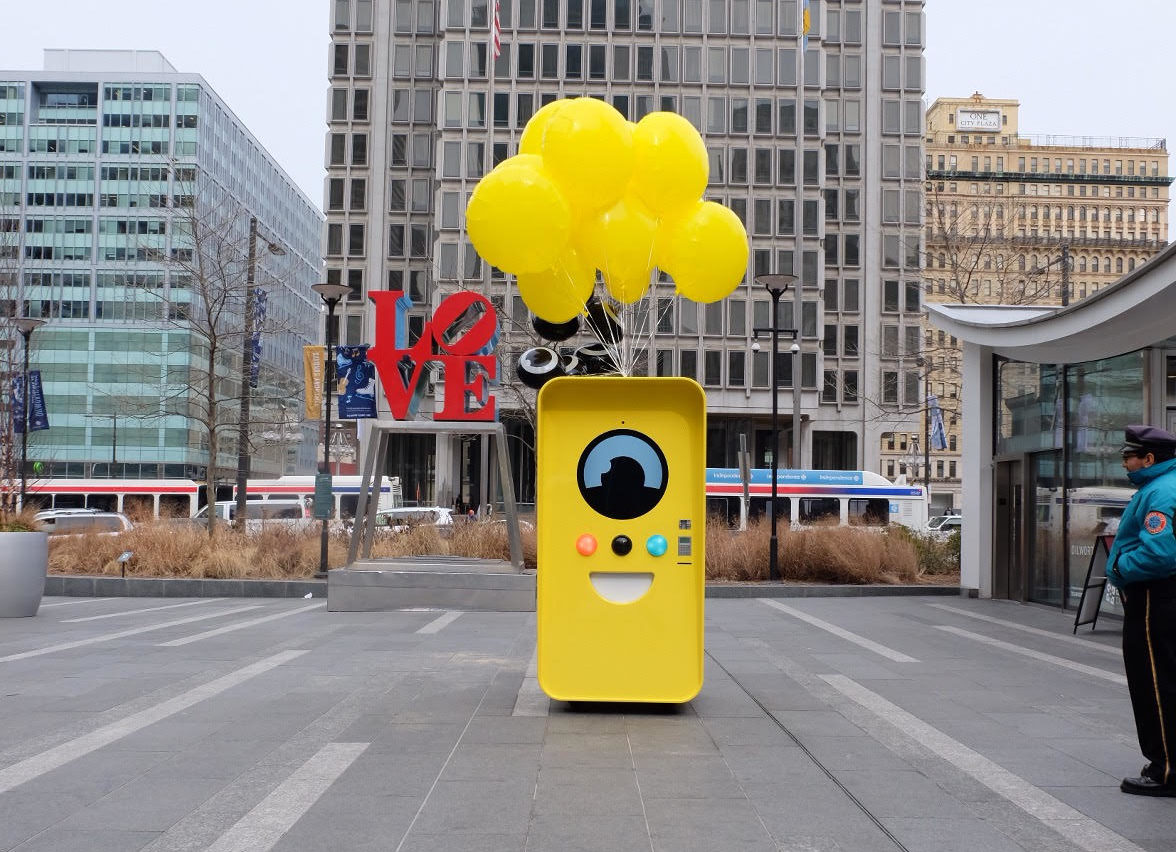
Your company is called Refinery29.
You're looking for something creative to capture your audience.
What do you do?
You create an annual event, and you name it 29Rooms.
It's witty and memorable. Not to mention that it's also on-brand.
In a nutshell, the 29Rooms event is like a funhouse for adults. There are 29 rooms of interactive art, and attendees can experience something different in each of the rooms.
For instance, one of the rooms is an art studio where visitors can create experimental art for themselves. The next room is all about self-care. Guests can relax in a crystal cave, meditate and listen to life-affirming mantras.
Oh, and there's also a tinsel-filled room that's reserved only for dance breaks.
Lesson learned: Create a memorable experience that people will want to attend and brag about later on their social media accounts.
Here's a fact:
When people are asked about their guilty pleasure, they almost always say ice cream – it's great in the heat, it's sweet, and comes in a wide variety of flavors.
Here's another fact:
Uber is all about new experiences and bringing unique opportunities to people.
And what a better surprise than an ice cream truck headed your way?
And not just any kind of ice cream: free ice cream.
Here's how the campaign worked:
If you lived in one of the 10 participating cities, you could request an Uber Ice Cream Truck and get five ice cream cones and a free silicone Rubber-stamped cone.
But that's not everything!
With that reusable cone, you could go to your nearest McDonald's and get a free soft-serve refill every Friday (from Aug. 11 to Sept. 22).
So much free ice cream!
Lesson learned: Surprise people with something they really crave by promoting your brand at the same time.
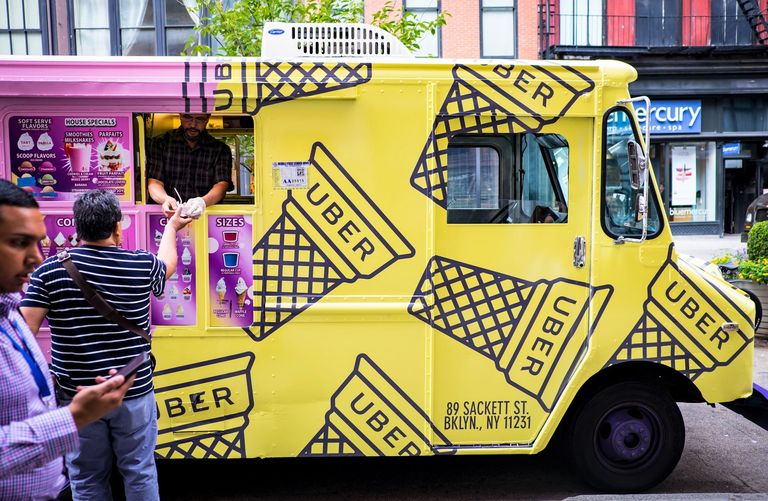
In 2010, during PayPal's developer conference in San Francisco, people could spot a giant block of ice in front of the Moscone Center.
And it wasn't just a regular block of ice.
It had hundreds of dollars locked beneath the surface.
There was also a note for everyone at the conference that read:
PayPal freezes your accounts!
Who could be trolling one of the most popular online payments companies?
It was a competitor company called WePay.
They were trolling PayPal to tell everyone who attended the conference that PayPal freezes their accounts (which was a real scandal back in the day) and that they should unfreeze their money by switching to WePay.
Cleverly done, right?
The stunt created a bit of drama that involved the co-founder, Rich Aberman, being chased down by a member of the security team.
Lesson learned: Pay attention to current scandals/rumors surrounding your competitors and use it to your advantage to create a buzz.

If you live anywhere else but in Germany, the name Wix might not be anything memorable or outrageous.
But for Germans, the name is the cause for much laughter because of its translation.
If you sprechen sie Deutsch, Wix in German means "to wank."
Being the bold brand that it is, Wix decided to take advantage of this somewhat uncomfortable situation and make it even more laughable.
First, the company highlighted the translation of its name in several online-only ads. But in 2019, it went a step further and came out with billboards that appeared all around Berlin.
People walking on the streets in Berlin could see some really interesting fun facts about "wixing" they may not have heard before.
Here are a few:
If you want to learn more facts about how German "wix", here's a websitethe company was polite enough to create.
Lesson learned: Discover something unusual or funny about your brand's name and use it to your advantage.
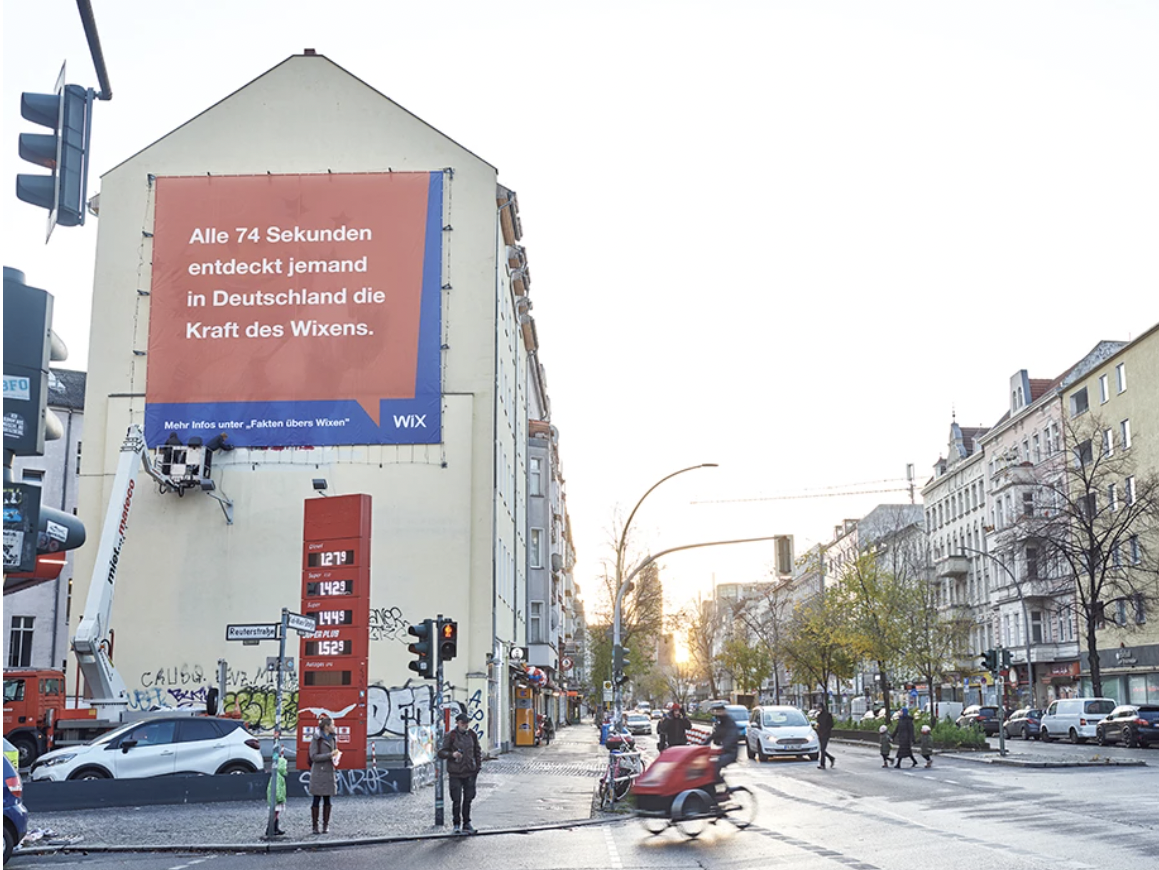
To promote the third season of the acclaimed TV series Narcos, Netflix launched a pretty interesting guerrilla marketing campaign.
They decided to recreate the LA drug scene back in the mid-90's when the drug market was mainly ruled by the Cali cartel.
What did the marketing guys do?
They stuck transparent stickers with images of rolled up dollar bills sprinkled with coke residue in nightclub bathrooms across Miami, Chicago, New York, and Los Angeles.
Why nightclubs?
If you watched the show, you would know that clubs were where the majority of people were doing cocaine in these cities back in the 90's.
They even took a step further and left a little note on the stickers that said:
"Here in the '90s? There’s an 80% chance this powder came from the Cali Cartel”.
Lesson learned: Generate a lot of buzz with non-traditional but fun advertising by thinking outside the box. Capture your target audience in a quirky way by incorporating some elements of the product/service you're promoting at a related location.

Have you ever wondered what kick-started the growth of Salesforce?
It was the genius marketing strategy of Marc Benioff that put Salesforce on the map.
Marc must be one of the craziest CEOs in the tech industry who uses guerrilla marketing tactics to steal the spotlight from his competitors and bring himself and his company to the center of attention.
One of his best stunts was the one that he pulled off in Cannes, France. During that time, one of their competitors, Siebel, was holding an event.
What did Benioff do?
He figured all attendees would fly into Nice and take a cab to the conference. So he rented all the airport taxis in Cannes and used the 45-minute drive to pitch Salesforce to the riders.
Benioff's tactics obviously worked. Today, Salesforce holds a 19.8% market share. Its largest competitors – Oracle, SAP, Adobe, and Microsoft – have a combined market share of 17.8%.
Lesson learned: In the guerilla marketing realm, there are no rules. You can have the most outrageous idea and bring it to life to get a competitive edge. Find out about your competitor's events and steal the spotlight by pulling off a bold stunt that will make people think of you everytime they think of your competitor.
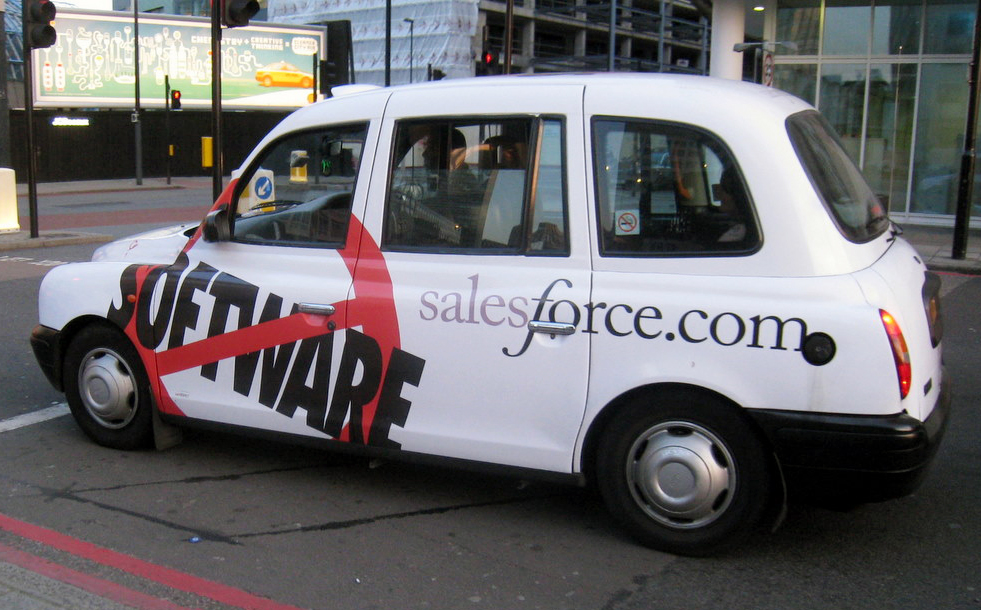
The next tactic on our list comes from Upwork, the biggest freelance marketplace today.
In its 2018 campaign called "Hey World," Upwork playfully offered help to busy celebrities and companies that are strapped with time and resources like the president, Elon Musk, George R.R. Martin, Dwayne "The Rock" Johnson, and even Nasa.
This multi-million dollar campaign aimed to attract more customers in Chicago, New York, and San Francisco.
It involved billboards that were set up in places regularly frequented by the target audience and corresponding videos, radio spots, and television takeovers.
Although NASA and Elon Musk may not have hired their talent from Upwork, this guerrilla marketing tactic surely won people's attention, including businesses that are in dire need of skilled talent.
Lesson learned: When producing your marketing content, make sure it is relevant and taps into current events that get plenty of buzz (example: George R.R. Martin and his dragged-out process of finishing the Song of Ice and Fire books or NASA and its slow approach to landing a human on Mars).
You're a multi-billion company that wants to give back to the community. The latest idea your team has come up with is awarding the best nonprofits who are dedicated to building a better community for the San Francisco Bay area.
But how do you decide which cause should be placed at the forefront of this campaign?
You let the Bay area citizens decide. After all, they're the ones who live in the community.
That's what Google did with their Google Impact Challenge campaign in 2015. The company set up interactive posters around the area that acted as public voting booths. Each poster featured the 10 nonprofits who made the most impact and the cause they support.
In the end, six of the most voted nonprofits each received a $500,000 grant, and the remaining four were awarded $250,000 each.
Not only was the campaign a great way to reward those who help the community, but it also raised awareness about the most alarming issues the Bay Area community was facing.
Lesson learned: Get the public involved in your project. Those involved are more likely to help share the good word. Don't hesitate to incorporate a charitable element into your guerrilla marketing stunts.
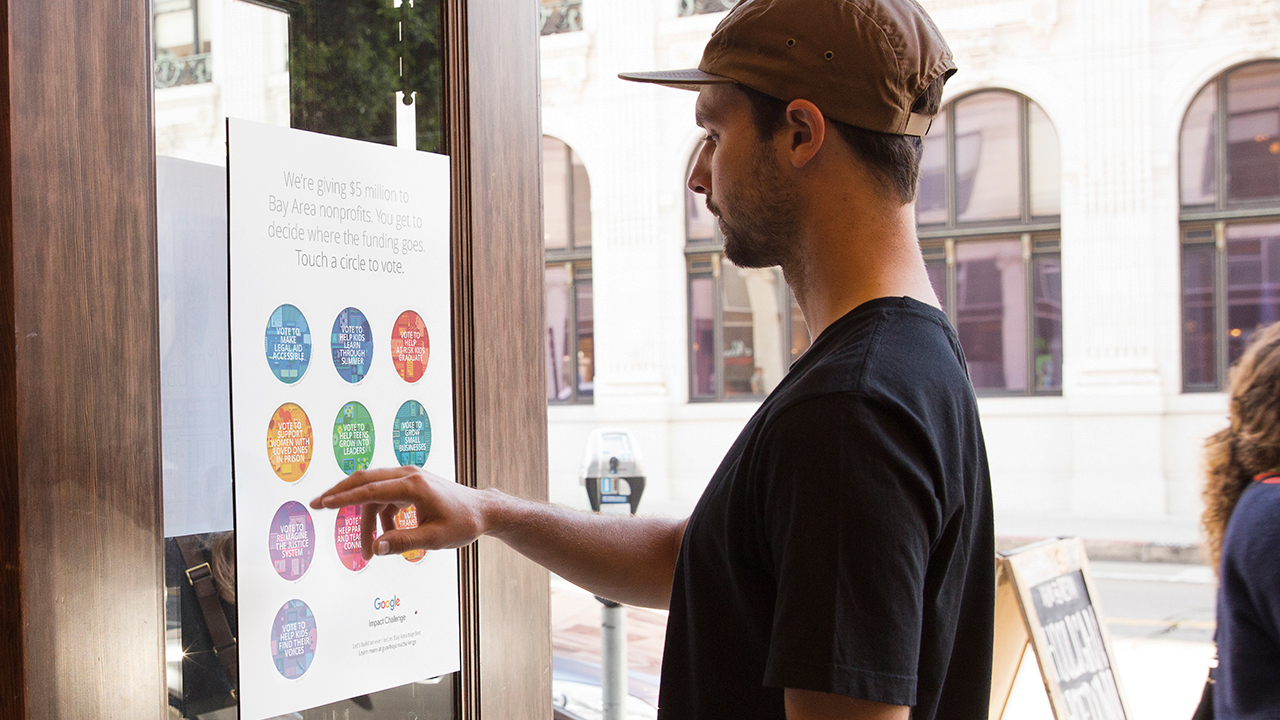
Marketing comes in several different forms.
From social media marketing and Google ads to traditional marketing, there are hundreds of tactics for winning more customers and raising brand awareness.
But the most attention-grabbing, impactful, and memorable type of marketing must be guerrilla marketing.
Think about it:
Are you more likely to remember one of the examples we mentioned in this post or an ad you saw on your Twitter account?
I'm 100% it's the former!
In this day and age, where people are bombarded with see-and-forget information, guerrilla marketing can create a lasting impression. So the next time you're meeting with your marketing team to discuss your social media campaign, brainstorm some creative ideas for a guerrilla marketing campaign, too.
Believe me: it'll be worth it. And remember: there are no rules in this game.

GrowSurf is modern referral program software that helps product and marketing teams launch an in-product customer referral program in days, not weeks. Start your free trial today.
Word of mouth marketing can be the strategy that skyrockets your business and takes it to another level. Here we tell you all you need to know about it.
Your SaaS solution may be the best thing since sliced bread. You know deep in your gut it can make the lives of your target audience significantly better. But if you’re not generating enough leads, chances are your SaaS business won’t stick around for long. So, in this blog post, we’ll take a look into 12 stupidly, simple ways that can help you generate more SaaS leads for your business.
One good way to create a successful referral program is to look at how other people did it. Case in point: Morning Brew. Want to learn how they built an audience of 2.5 million? This blog post breaks down the Morning Brew referral program in detail!